Plant Density and Health Evaluation in Green Stormwater Infrastructure Using Unmanned-Aerial-Vehicle-Based Imagery
Abstract
Featured Application
Abstract
1. Introduction
2. Methods
2.1. List of Instrumentation and Software
2.2. Plant Density and Health Identification Framework
2.3. Study Sites Selection
3. Results and Discussion
3.1. Plant Density Prediction and Validation
3.2. Plant Density Prediction and Validation
3.3. NDVI for Plant Health
3.4. Evaluation of Implementation in Additional Sites
4. Conclusions
Supplementary Materials
Author Contributions
Funding
Institutional Review Board Statement
Informed Consent Statement
Data Availability Statement
Acknowledgments
Conflicts of Interest
References
- Heidari, B.; Randle, S.; Minchillo, D.; Jaber, F.H. Green stormwater infrastructure: A critical review of the barriers and solutions to widespread implementation. Wiley Interdiscip. Rev. Water 2023, 10, e1625. [Google Scholar] [CrossRef]
- Spahr, K.M.; Bell, C.D.; McCray, J.E.; Hogue, T.S. Greening up stormwater infrastructure: Measuring vegetation to establish context and promote cobenefits in a diverse set of US cities. Urban For. Urban Green. 2020, 48, 126548. [Google Scholar]
- Andersson, E.; McPhearson, T.; Kremer, P.; Gomez-Baggethun, E.; Haase, D.; Tuvendal, M.; Wurster, D. Scale and context dependence of ecosystem service providing units. Ecosyst. Serv. 2015, 12, 157–164. [Google Scholar] [CrossRef]
- Luan, B.; Yin, R.; Xu, P.; Wang, X.; Yang, X.; Zhang, L.; Tang, X. Evaluating Green Stormwater Infrastructure strategies efficiencies in a rapidly urbanizing catchment using SWMM-based TOPSIS. J. Clean. Prod. 2019, 223, 680–691. [Google Scholar] [CrossRef]
- Abhijith, K.V.; Kumar, P. Field investigations for evaluating green infrastructure effects on air quality in open-road conditions. Atmos. Environ. 2019, 201, 132–147. [Google Scholar] [CrossRef]
- Shafique, M.; Kim, R. Application of green blue roof to mitigate heat island phenomena and resilient to climate change in urban areas: A case study from Seoul, Korea. J. Water Land Dev. 2017, 33, 165. [Google Scholar] [CrossRef]
- Lemieux, C.; Bichai, F.; Boisjoly, G. Synergy between green stormwater infrastructure and active mobility: A comprehensive literature review. Sustain. Cities Soc. 2023, 99, 104900. [Google Scholar] [CrossRef]
- Ebrahimian, A.; Wilson, B.N.; Gulliver, J.S. Improved methods to estimate the effective impervious area in urban catchments using rainfall-runoff data. J. Hydrol. 2016, 536, 109–118. [Google Scholar] [CrossRef]
- Ebrahimian, A.; Gulliver, J.S.; Wilson, B.N. Estimating effective impervious area in urban watersheds using land cover, soil character and asymptotic curve number. Hydrol. Sci. J. 2018, 63, 513–526. [Google Scholar] [CrossRef]
- Nowak, D.J.; Crane, D.E.; Stevens, J.C. Air pollution removal by urban trees and shrubs in the United States. Urban For. Urban Green. 2006, 4, 115–123. [Google Scholar] [CrossRef]
- Wróblewska, K.; Jeong, B.R. Effectiveness of plants and green infrastructure utilization in ambient particulate matter removal. Environ. Sci. Eur. 2021, 33, 110. [Google Scholar] [CrossRef] [PubMed]
- Muerdter, C.P.; Wong, C.K.; LeFevre, G.H. Emerging investigator series: The role of vegetation in bioretention for stormwater treatment in the built environment: Pollutant removal, hydrologic function, and ancillary benefits. Environ. Sci. Water Res. Technol. 2018, 4, 592–612. [Google Scholar] [CrossRef]
- Vijayaraghavan, K.; Biswal, B.K.; Adam, M.G.; Soh, S.H.; Tsen-Tieng, D.L.; Davis, A.P.; Chew, S.H.; Tan, P.Y.; Babovic, V.; Balasubramanian, R. Bioretention systems for stormwater management: Recent advances and future prospects. J. Environ. Manag. 2021, 292, 112766. [Google Scholar] [CrossRef] [PubMed]
- Payne, E.G.; Pham, T.; Deletic, A.; Hatt, B.E.; Cook, P.L.; Fletcher, T.D. Which species? A decision-support tool to guide plant selection in stormwater biofilters. Adv. Water Resour. 2018, 113, 86–99. [Google Scholar] [CrossRef]
- Leveau, L.M.; Isla, F.I.; Bellocq, M.I. Predicting the seasonal dynamics of bird communities along an urban-rural gradient using NDVI. Landsc. Urban Plan. 2018, 177, 103–113. [Google Scholar] [CrossRef]
- Hunt, W.F.; Davis, A.P.; Traver, R.G. Meeting Hydrologic and Water Quality Goals through Targeted Bioretention Design. J. Environ. Eng. 2012, 138, 698–707. [Google Scholar] [CrossRef]
- Liu, S.; Baret, F.; Andrieu, B.; Burger, P.; Hemmerlé, M. Estimation of wheat plant density at early stages using high resolution imagery. Front. Plant Sci. 2017, 8, 739. [Google Scholar] [CrossRef] [PubMed]
- Liu, S.; Baret, F.; Allard, D.; Jin, X.; Andrieu, B.; Burger, P.; Hemmerlé, M.; Comar, A. A method to estimate plant density and plant spacing heterogeneity: Application to wheat crops. Plant Methods 2017, 13, 38. [Google Scholar] [CrossRef] [PubMed]
- Peng, J.; Rezaei, E.E.; Zhu, W.; Wang, D.; Li, H.; Yang, B.; Sun, Z. Plant Density Estimation Using UAV Imagery and Deep Learning. Remote Sens. 2022, 14, 5923. [Google Scholar] [CrossRef]
- Shrestha, D.S.; Steward, B.L. Shape and size analysis of corn plant canopies for plant population and spacing sensing. Appl. Eng. Agric. 2005, 21, 295–303. [Google Scholar] [CrossRef][Green Version]
- Jayasuriya, N.; Guo, Y.; Hu, W.; Ghannoum, O. Machine vision-based plant height estimation for protected crop facilities. Comput. Electron. Agric. 2024, 218, 108669. [Google Scholar] [CrossRef]
- Velumani, K.; Lopez-Lozano, R.; Madec, S.; Guo, W.; Gillet, J.; Comar, A.; Baret, F. Estimates of maize plant density from UAV RGB images using faster-RCNN detection model: Impact of the spatial resolution. Plant Phenomics 2021, 2021, 9824843. [Google Scholar] [CrossRef] [PubMed]
- Bannari, A.; Morin, D.; Bonn, F.; Huete, A. A review of vegetation indices. Remote Sens. Rev. 1995, 13, 95–120. [Google Scholar] [CrossRef]
- Jackson, R.D.; Huete, A.R. Interpreting vegetation indices. Prevent. Vet. Med. 1991, 11, 185–200. [Google Scholar] [CrossRef]
- Davidson, C.; Jaganathan, V.; Sivakumar, A.N.; Czarnecki, J.M.P.; Chowdhary, G. NDVI/NDRE prediction from standard RGB aerial imagery using deep learning. Comput. Electron. Agric. 2022, 203, 107396. [Google Scholar] [CrossRef]
- Rouse, J.W., Jr.; Haas, R.H.; Schell, J.A.; Deering, D.W. Monitoring Vegetation Systems in the Great Plains with ERTS; NASA Special Publication: Greenbelt, MD, USA, 1974; pp. 309–317. [Google Scholar]
- Krishnaswamy, J.; Bawa, K.S.; Ganeshaiah, K.N.; Kiran, M.C. Quantifying and mapping biodiversity and ecosystem services: Utility of a multi-season NDVI based Mahalanobis distance surrogate. Remote Sens. Environ. 2009, 113, 857–867. [Google Scholar] [CrossRef]
- Martínez-Harms, M.J.; Balvanera, P. Methods for mapping ecosystem service supply: A review. Int. J. Biodivers. Sci. Ecosyst. Serv. Manag. 2012, 8, 17–25. [Google Scholar] [CrossRef]
- Mangewa, L.J.; Ndakidemi, P.A.; Alward, R.D.; Kija, H.K.; Bukombe, J.K.; Nasolwa, E.R.; Munishi, L.K. Comparative assessment of UAV and sentinel-2 NDVI and GNDVI for preliminary diagnosis of habitat conditions in Burunge wildlife management area, Tanzania. Earth 2022, 3, 769–787. [Google Scholar] [CrossRef]
- Xiang, T.Z.; Xia, G.S.; Zhang, L. Mini-unmanned aerial vehicle-based remote sensing: Techniques, applications, and prospects. IEEE Geosci. Remote Sens. Mag. 2019, 7, 29–63. [Google Scholar] [CrossRef]
- Shahbazi, M.; Théau, J.; Ménard, P. Recent applications of unmanned aerial imagery in natural resource management. GIScience Remote Sens. 2014, 51, 339–365. [Google Scholar] [CrossRef]
- Xiao, Q.; McPherson, E.G. Tree health mapping with multispectral remote sensing data at UC Davis, California. Urban Ecosyst. 2005, 8, 349–361. [Google Scholar] [CrossRef]
- Torresan, C.; Berton, A.; Carotenuto, F.; Di Gennaro, S.F.; Gioli, B.; Matese, A.; Miglietta, F.; Vagnoli, C.; Zaldei, A.; Wallace, L. Forestry applications of UAVs in Europe: A review. Int. J. Remote Sens. 2017, 38, 2427–2447. [Google Scholar] [CrossRef]
- Dimitrov, S.; Georgiev, G.; Georgieva, M.; Gluschkova, M.; Chepisheva, V.; Mirchev, P.; Zhiyanski, M. Integrated assessment of urban green infrastructure condition in Karlovo urban area by in-situ observations and remote sensing. One Ecosyst. 2018, 3, e21610. [Google Scholar] [CrossRef]
- Prettyman, K.; Babbar-Sebens, M.; Parrish, C.E.; Babbar-Sebens, J.M. A feasibility study of uninhabited aircraft systems for rapid and cost-effective plant stress monitoring at green stormwater infrastructure facilities. J. Hydroinformatics 2021, 23, 417–437. [Google Scholar] [CrossRef]
- DJI. Phantom 4 Pro/Pro+ User Manual; DJI, 2017. Available online: https://www.dji.com/phantom-4-pro/info (accessed on 1 May 2021).
- MAPIR. MAPIR Survey3 Quick Start Guide. 2017. Available online: https://cdn.shopify.com/s/files/1/0878/4732/files/MAPIR_Survey3_Manual_v1.pdf?12365009533491002433 (accessed on 1 May 2021).
- WebODM. (n.d.) WebODM Drone Mapping Software. OpenDroneMap. Available online: https://www.opendronemap.org/webodm/ (accessed on 12 June 2021).
- Zecevic, Z.; Popovic, T.; Krstajic, B. Cloud Based Solution for 22nd Automatic Image Mosaicking and Georeferencing. In Proceedings of the 22nd International Scientific-Professional Conference Information Technology; 2017. Available online: https://researchgate.net/publication/315839453 (accessed on 10 July 2022).
- Candiago, S.; Remondino, F.; De Giglio, M.; Dubbini, M.; Gattelli, M. Evaluating multispectral images and vegetation indices for precision farming applications from UAV images. Remote Sens. 2015, 7, 4026–4047. [Google Scholar] [CrossRef]
- Qian, X.; Xue, J.; Yang, Y.; Lee, S.W. Thermal Properties and Combustion-Related Problems Prediction of Agricultural Crop Residues. Energies 2021, 14, 4619. [Google Scholar] [CrossRef]
- Rainey, W.; McHale, M.; Arabi, M. Characterization of co-benefits of green stormwater infrastructure across ecohydrologic regions in the United States. Urban For. Urban Green. 2022, 70, 127514. [Google Scholar] [CrossRef]

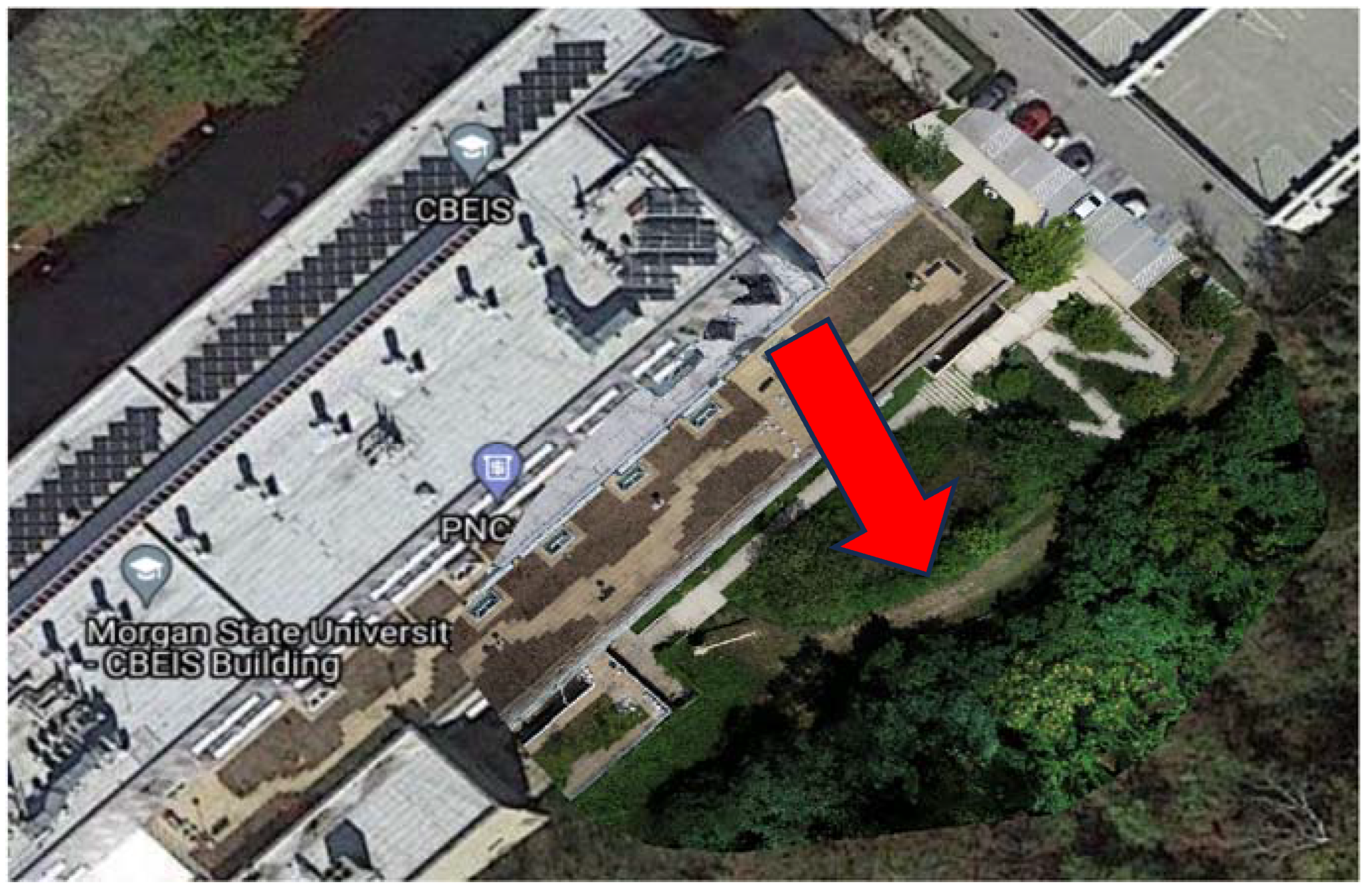
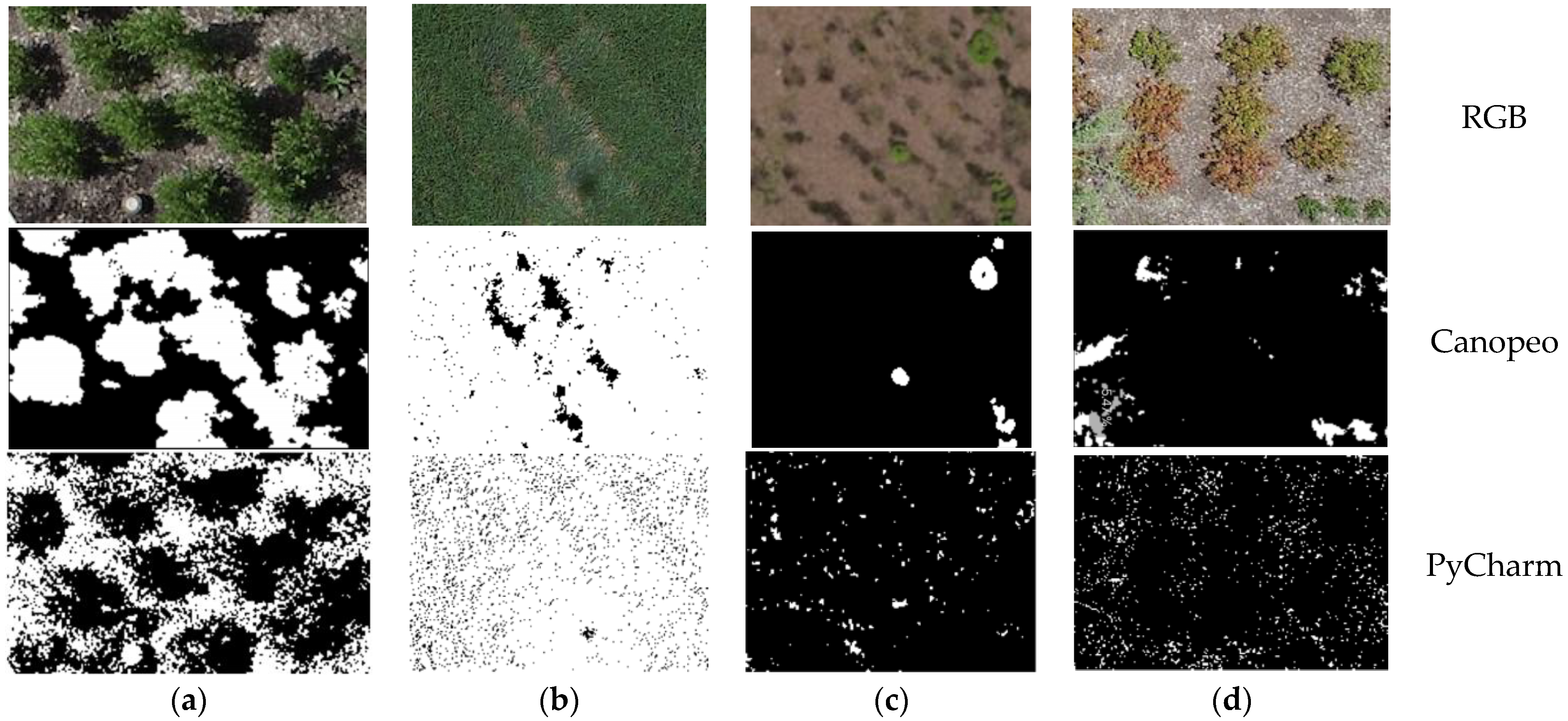


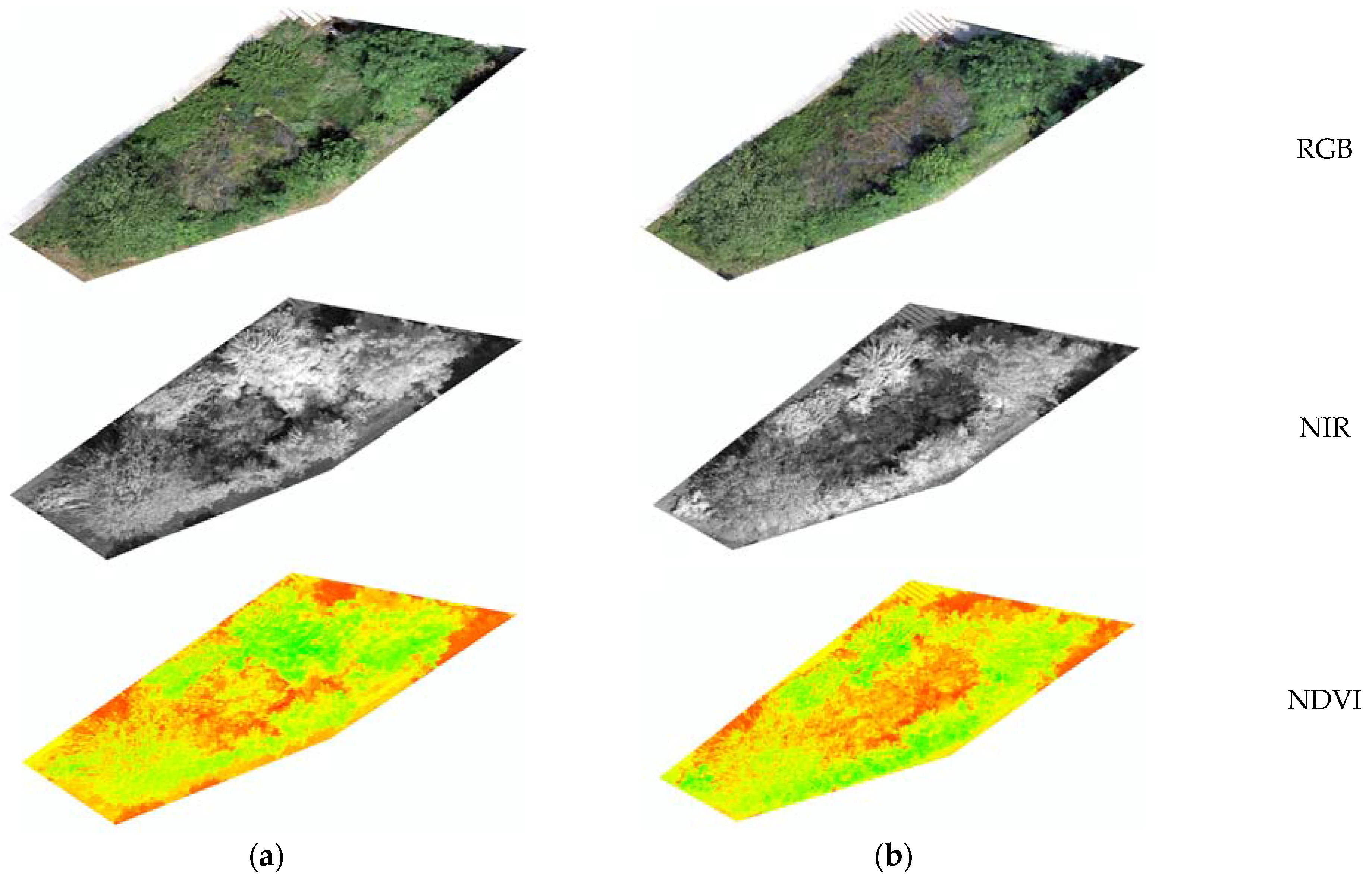
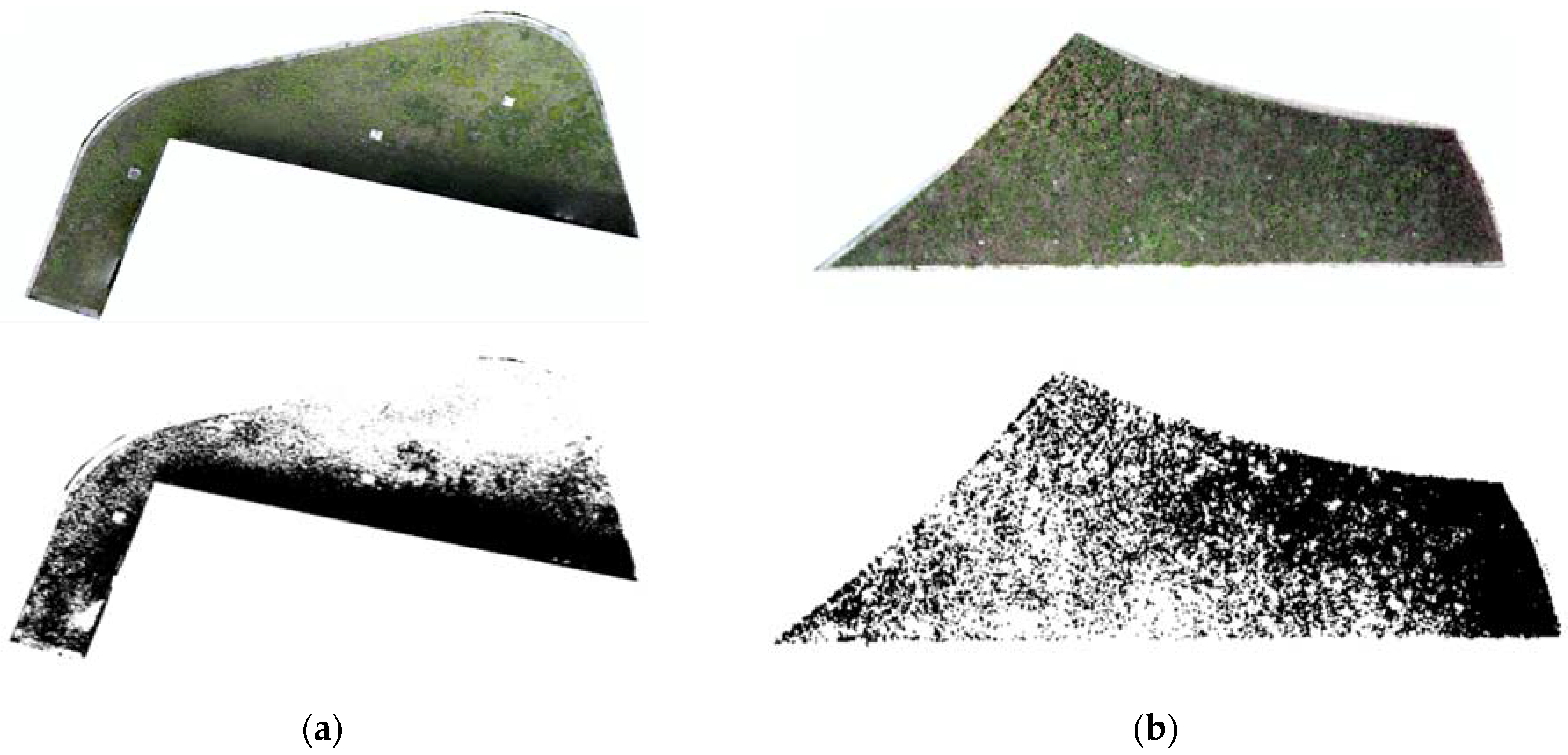
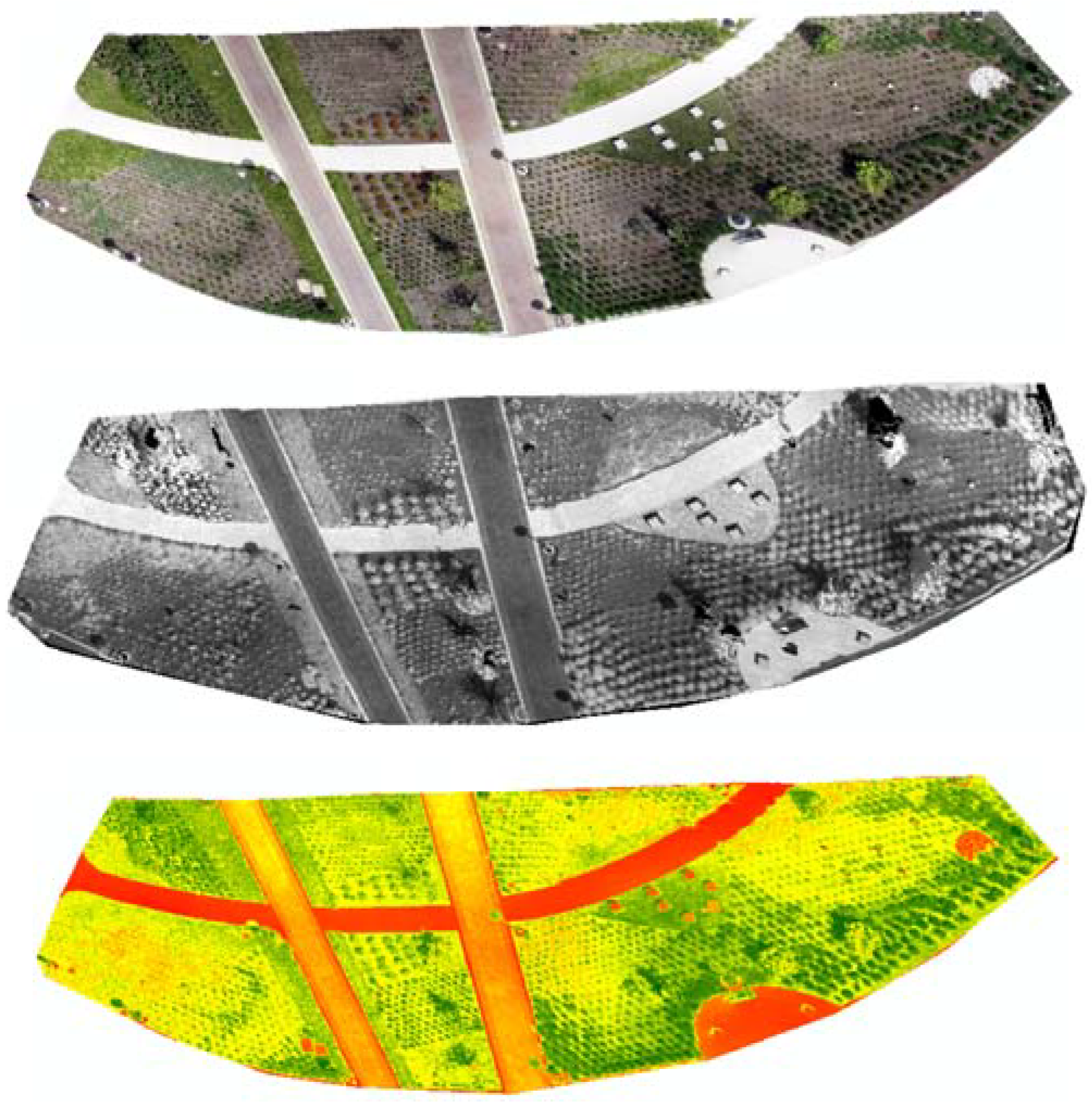
| No. | Name | GSI Type | MD_North 1 | MD_East 1 | Year Built | Coordinates (Latitude, Longitude) | Collection Date (2021) |
|---|---|---|---|---|---|---|---|
| 1 | CBEIS #1 | Bioretention | 187,162.20900 | 436,344.28000 | 2012 | 39.351953, −76.578343 | - |
| 2 | CBEIS #2 | Bioretention | 187,113.57600 | 436,268.57600 | 2012 | 39.351518, −76.579224 | 27 May/28 June |
| 3 | CBEIS #3 | Bioretention | 187,230.99400 | 436,342.13500 | 2012 | 39.352573, −76.578364 | - |
| 4 | CBEIS | Green roof | 187,076.04700 | 436,213.66600 | 2012 | 39.351183, −76.579863 | 3 September |
| 5 | CBEIS | Permeable pavement | 187,224.81000 | 436,334.30700 | 2012 | 39.352517, −76.578455 | - |
| 6 | CBEIS | Oil/grit separator | 187,178.68400 | 436,284.47300 | 2012 | 39.352104, −76.579036 | - |
| 7 | GSBM | Bioretention | 185,898.43700 | 435,461.47700 | 2015 | 39.340606, −76.588651 | - |
| 8 | GSBM | Green roof | 185,956.83500 | 435,517.33600 | 2015 | 39.341130, −76.588000 | 3 September |
| 9 | BSSC 2 #1 | Micro-bioretention | 186,040.89000 | 435,446.26600 | 2017 | 39.341890, −76.588820 | - |
| 10 | BSSC #2 | Micro-bioretention | 186,028.51900 | 435,410.97700 | 2017 | 39.341780, −76.589230 | - |
| 11 | BSSC #3 | Micro-bioretention | 186,024.34600 | 435,470.47900 | 2017 | 39.341740, −76.588540 | - |
| 12 | BSSC | Green roof | 186,009.97200 | 435,483.47500 | 2017 | 39.341610, −76.588390 | - |
| 13 | LB 3 | Micro-bioretention | 186,020.65200 | 435,617.57800 | 2017 | 39.341701, −76.586834 | - |
| 14 | ESRL | Green roof | 186,325.25200 | 435,724.28700 | 2007 | 39.344440, −76.585580 | 3 September |
| 15 | CTTH | Micro-bioretention | N/A | N/A | 2020 | N/A | 29 May |
| 16 | CTTH | Rain garden | N/A | N/A | 2020 | N/A | - |
| 17 | CTTH | Green roof | N/A | N/A | 2020 | N/A | 29 May |
| 18 | COMM 4 | Pond | 186,716.92100 | 435,964.39900 | 2006 | 39.347958, −76.582774 | - |
| 19 | COMM | Permeable pavement | 186,824.20600 | 435,978.10200 | 2006 | 39.348924, −76.582609 | - |
| 20 | AH 5 | Pond | 185,704.34600 | 435,902.97700 | 1922 | 39.338840, −76.583540 | - |
| Components | Canopeo (%) | Programming Code (%) | Threshold | Category |
|---|---|---|---|---|
| Tree1 | 96.51 | 95.50 | 40 | Tree |
| Tree2 | 69.97 | 65.90 | 70 | |
| Tree3 | 43.09 | 42.19 | 85 | |
| Grass1 | 94.69 | 93.03 | 50 | Grass |
| Grass2 | 100.00 | 100.00 | 40 | |
| Grass3 | 95.84 | 94.20 | 30 | |
| Soil1 | 0.02 | 0.03 | 105 | Soil |
| Soil2 | 2.51 | 2.65 | 113 | |
| Soil3 | 4.05 | 4.49 | 131 | |
| Unhealty_Tree1 | 0.14 | 0.13 | 231 | Unhealthy tree |
| Unhealty_Tree2 | 5.47 | 4.96 | 180 | |
| Unhealty_Tree3 | 0.79 | 0.80 | 131 | |
| AAE = 0.080, ABE = 0.032, R2 = 0.958 | ||||
| Classes | Color | NDVI Scale | Color | NDVI Scale |
|---|---|---|---|---|
| Excellent |  | 0.67~1.00 |  | 0.34~0.67 |
| Good |  | 0.00~0.34 |  | 0.00~−0.34 |
| Poor |  | −0.34~−0.67 |  | −0.67~−1.00 |
Disclaimer/Publisher’s Note: The statements, opinions and data contained in all publications are solely those of the individual author(s) and contributor(s) and not of MDPI and/or the editor(s). MDPI and/or the editor(s) disclaim responsibility for any injury to people or property resulting from any ideas, methods, instructions or products referred to in the content. |
© 2024 by the authors. Licensee MDPI, Basel, Switzerland. This article is an open access article distributed under the terms and conditions of the Creative Commons Attribution (CC BY) license (https://creativecommons.org/licenses/by/4.0/).
Share and Cite
Xue, J.; Qian, X.; Kang, D.H.; Hunter, J.G. Plant Density and Health Evaluation in Green Stormwater Infrastructure Using Unmanned-Aerial-Vehicle-Based Imagery. Appl. Sci. 2024, 14, 4118. https://doi.org/10.3390/app14104118
Xue J, Qian X, Kang DH, Hunter JG. Plant Density and Health Evaluation in Green Stormwater Infrastructure Using Unmanned-Aerial-Vehicle-Based Imagery. Applied Sciences. 2024; 14(10):4118. https://doi.org/10.3390/app14104118
Chicago/Turabian StyleXue, Jingwen, Xuejun Qian, Dong Hee Kang, and James G. Hunter. 2024. "Plant Density and Health Evaluation in Green Stormwater Infrastructure Using Unmanned-Aerial-Vehicle-Based Imagery" Applied Sciences 14, no. 10: 4118. https://doi.org/10.3390/app14104118
APA StyleXue, J., Qian, X., Kang, D. H., & Hunter, J. G. (2024). Plant Density and Health Evaluation in Green Stormwater Infrastructure Using Unmanned-Aerial-Vehicle-Based Imagery. Applied Sciences, 14(10), 4118. https://doi.org/10.3390/app14104118








